When someone becomes interested in feeding their dog a homemade diet, I always advise them to read at least one book on the subject before getting started. But which one should you choose? Guidelines run the gamut from diets that have been analyzed to ensure they are complete and balanced, to those that are dangerously inadequate. How do you tell the difference?
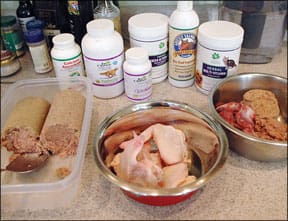
288
I decided to check out the homemade diet books that are currently available. Some of them I’d read before, but wanted to take a fresh look at; others were new to me. It’s been an eye-opening experience.
I found some books that I’d liked a lot when I first read them didn’t hold up well now that I know more about canine nutrition, and in comparison with others that have been published since. A few new books and improved new editions were pleasant surprises, but I found that other popular books lacked any credible guidance on important topics such as dietary calcium, an omission that will lead to serious harm over time.
Whichever book you choose, it’s important that you read the whole book, or at least all of the sections pertaining to diet, rather than just looking at recipes. All of the books I recommend contain critical information about the diet in the text that you need to know before using their recipes or guidelines. If you just follow the recipes, you may miss essential details such as allowable substitutions, optional ingredients, and recommended supplements.
You may ask why I recommend reading books in the Internet age. Books offer a more complete and organized view of the author’s approach to diet, while even good websites often compress the information too much, leaving out important details, or scattering it onto different pages, making it easy to miss essential components. E-mail lists can be a good resource for beginners when they run into questions, but they’re not organized in a way that lets you learn everything you need to know.
Also, some e-mail lists are dominated by people with a single point of view, who will attack, ridicule, and remove anyone who disagrees, ensuring that you see only one side. Others allow anyone to say anything, meaning the advice you receive may be very good or completely misguided.
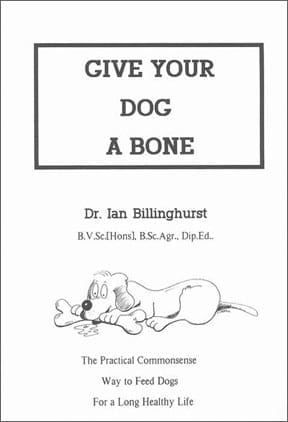
288
Books allow you to see the big picture, refer back to relevant details, and (one would hope) gain a clear understanding of the whole diet before you start. You can read reviews, check references, and decide whether the information seems reliable. If you take the time to read a book thoroughly, you’ll be better able to distinguish the good from the bad when it comes to advice found on websites and e-mail lists.
I’ll start this month by looking at books that focus on diets based on raw meaty bones (RMBs). Next month, I’ll review some excellent new books that offer guidelines for diets where RMBs are optional. Last, I’ll discuss books that have only boneless recipes, either raw or cooked.
Most of the books reviewed are available from Amazon.com and bookstores. A few can be purchased only from pet book specialists (such as Dogwise.com), holistic pet supply stores, or from the author.
Some books contain additional chapters on such topics as herbs, health issues, the evolution of the dog, and more. I have ignored those parts and focused my reviews solely on dietary guidelines and recipes. My recommendation of a book’s diet does not mean that I endorse anything else that the book may include.
The origins of RMB diets
When I first became interested in feeding my dogs a homemade diet based on raw meaty bones back in 1997, the choice of books was easy, as only one book on the subject existed. Australian veterinarian Ian Billinghurst published Give Your Dog a Bone in 1993. At least six more books that focus on RMB diets were published later, including two more from Dr. Billinghurst, as the popularity of the diets grew. Most offer variations on his original diet, though another Australian veterinarian, Tom Lonsdale, introduced a distinct style of feeding based on whole prey.

288
Proponents of raw meaty bones diets believe that this style of feeding most closely mimics the evolutionary diet of the dog. Raw meaty bones are those that can be fully consumed by dogs, as opposed to “recreational” bones, such as marrow and knuckle bones. Typical RMBs used by raw feeders include chicken necks, backs, wings, and leg quarters; turkey, lamb, pork, and beef necks; and lamb and pork breasts (riblets). RMBs provide a perfect balance of calcium and phosphorus, along with other nutrients.
It’s vital to realize that these diets consist of much more than just RMBs, which is why reading a book on the topic is strongly advised. Again, it’s important to choose the right book.
One of the biggest variations between books on RMB diets is the amount of bone included in the diet. Some books recommend feeding diets that are two-thirds or more RMBs. Too much bone provides excess calcium that can contribute to skeletal disease in large-breed puppies, such as hip dysplasia, hypertrophic osteodystrophy (HOD), and osteochondritis dissecans (OCD). Because calcium binds other nutrients, I believe that even adult dogs do better if the diet contains no more than 50 percent RMBs.
With that in mind, let’s take a look at the available books on feeding your dog a RMB-based diet.
Dr. Billinghurst’s books
Australian veterinarian Ian Billinghurst wrote the first popular book on diets that include RMBs, which he called BARF diets, for “bones and raw food” or “biologically appropriate raw food.” His diet is based on the natural diet of wolves and wild dogs. He later wrote two more books, Grow Your Pup with Bones, on feeding puppies and dogs used for breeding; and The BARF Diet, an updated and condensed version of his first book.
I have a soft spot in my heart for Billinghurst’s first book, as it’s the one that I relied on when I started feeding a raw diet in 1998. The book has a tremendous amount of detail about the various ingredients that go into the diet, and helped me grasp the concepts of balance over time; feeding raw meaty bones; and that if we can feed our children without resorting to “complete and balanced” meals from a bag or can, we can do the same for our dogs.
Billinghurst’s books can be frustrating, though. The information is disorganized. None of the books contains an index. If you want recipes or simple, clear instructions, you will not like Billinghurst’s books. Even those who appreciate the details on the nutritional benefits of each type of food may find it difficult to extract the specific elements needed to formulate a diet and determine how much to feed.
The foods and ratios used in all three books are similar. Billinghurst recommends feeding a diet that is approximately 60 percent RMBs, 15 to 20 percent vegetables and fruits, 10 to 15 percent organs, and the rest a variety of “additives,” including eggs, fish, muscle meat, oils, table scraps, grains, legumes, yogurt, and raw milk.
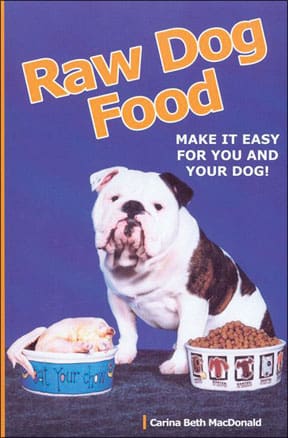
288
Billinghurst also adds whole food supplements: cod liver oil, apple cider vinegar, brewer’s yeast, honey, kelp, alfalfa, and garlic. He suggests supplementing with vitamins A, B-complex, C, D, and E, and offering the dog larger (recreational) bones.
Billinghurst stresses the need for variety in all three books, but he’s not consistent. In his first book, for example, he says that puppies can be fed up to 80 percent RMBs, stating, “We have found that we can get away with feeding puppies almost one hundred percent chicken wings, chicken necks, lamb ‘off cuts,’ and very little of anything else.” This advice is irresponsible, as it could lead to serious nutritional inadequacies and excesses that may cause lasting harm.
Feeding methodology varies between the three books. In the first, Billinghurst suggests feeding different foods at different meals. Over three weeks, you would feed 10 meals of RMBs, 4 vegetable, 1 starch, 1 grain/legume, 1 meat, 2 milk, and 1 or 2 organ meat meals.
The second book introduces the “patty,” a mix of all foods except RMBs (though those can be included in small amounts). Billinghurst suggests alternating between RMB and patty meals.
The third book offers two feeding choices: alternating RMB meals with a combination of other foods, such as meat (some including bone), organs, vegetables, fruit, and additives; or feeding “multi-mix patties,” consisting of all foods, including RMBs, ground together. The latter ties in with the introduction of “Dr. Billinghurst’s Meat and Bone Minces” from a company, BARF World, that he helped found (he is no longer affiliated with the company). The third book also places more emphasis on variety rather than feeding primarily chicken necks, wings, and carcasses.
The first two books are both quite long. While they are filled with valuable details and concepts, they unfortunately also contain misinformation about such things as the amount of protein, calcium, and phosphorus in commercial diets, and problems caused by too much protein that have since been disproved. The third book is shorter, making it easier to follow, and leaves out most of the earlier incorrect claims.
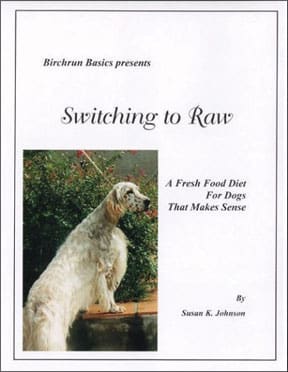
288
None of the three books provides good guidelines for how much to feed. All contain at least a few recommendations outside the scope of the general diet that I consider dangerous, such as feeding too much bone to puppies, frequent or prolonged fasting, and starving dogs who are overweight and puppies with skeletal problems by feeding them almost entirely vegetables.
A large portion of the second book is devoted to topics (health issues, breeding, and history) that are beyond the scope of this review.
Good starter book
Carina Beth MacDonald uses a lighthearted approach to cover the basics of a RMB diet without making things too complicated. Recommended proportions are 50 percent RMBs, 20 percent boneless meat, 5 to 10 percent organs, and 20 to 25 percent veggies, eggs, and fruit. In my opinion, this is a better ratio than other books that recommend a higher proportion of RMBs. Optional ingredients include dairy products, grains, apple cider vinegar, blackstrap molasses, garlic, ginger, nuts, legumes, and leftovers.
MacDonald’s book covers all the basics that a beginning raw feeder needs to know: what bony parts to feed, other foods to include in the diet, preparation, and how much to feed (as a percentage of ideal body weight). Note that the amounts given for puppies and small dogs (up to 10 percent of body weight daily) are too high. Recommended nutritional supplements include fish oil and vitamins C and E. Additional chapters go over customizing the diet based on age and size, problem solving, and answers to common questions.
I think this is one of the better “getting started” books for raw feeders, as it covers all the basics in a manner that is clear and easy to follow. The index is also helpful when you want to refer back to specific details as you put your diet together.
Billinghurst devotee
Switching to Raw is a very simple and easy-to-follow translation of the first Billinghurst book. Both recommend feeding at least 60 percent RMBs; Susan K. Johnson’s sample menu suggests feeding two RMB meals every other day, with one meal of RMBs and one meal of other foods on alternate days. This comes to 75 percent RMBs in the overall diet, which I believe is too much.

288
Instead, I would advise feeding just one RMB meal and rotating between the other foods Johnson recommends for the second meal each day.
In addition to RMBs, Johnson’s diet includes fish, eggs, organ meats (15 percent of the total diet), muscle (boneless) meat, and vegetables, with grains being optional. She gives guidelines for how much to feed dogs that weigh 20, 50, and 80 pounds, broken into meals of RMBs; vegetables with fish and egg; muscle meat with egg; and organ meat with egg.
Recommended supplements include fish oil and flaxseed or hemp oil; kelp and alfalfa; vitamins B-complex, C, and E; cod liver oil; digestive enzymes and probiotics; and molasses (although the recipes in the “Amounts to Feed” section leave out vitamin E).
Note that the recommendation to feed puppies up to 10 percent of their body weight daily is too high.
Other sections include information on treats and recreational bones; making the switch; what to expect; and shopping and preparation. The book does not address possible problems with RMBs for dogs who gulp their food.
Not recommended
Schultze wrote one of the early books on RMB diets. Her diet consists of muscle and organ meat, RMBs, eggs, and a very small amount of vegetables. Recommended supplements include kelp, alfalfa, cod liver oil, “EFAs,” and vitamin C.
Schultze’s book is filled with absolutes. She tells you to feed just one meal a day, and fast your dog one day a week. You’re not allowed to use aluminum foil for storage. She avoids both grains and dairy products, inferring without evidence that dietary guidelines for dogs with cancer will also help to prevent cancer. She makes other unsupported claims, such as that most pets cannot tolerate yeast. Other statements are just odd, such as advising not to feed raw salmon “unless it has tested free of salmon poisoning.” Testing for the parasite that causes salmon poisoning is not a viable option for dog owners.
The kind of details that would enable a dog owner to feed this diet are lacking here. A few examples: Schultze recommends feeding fish, but offers no suggestions as to the type of fish. Instructions for adding oils are vague. Food ratios are never given and feeding guidelines are unclear. She provides sample amounts to feed dogs weighing 10, 50, and 100 pounds, but ratios cannot be calculated because amounts are in different units. To illustrate, this is what she says to feed a 50-pound dog: “3/4-1 cup muscle meat (plus organ meat or egg), 1 turkey neck or 6 chicken necks, and 3 Tbl veggies, pulped.” Supplement amounts are also given: “2 tsp kelp/alfalfa, 1 tsp cod liver oil, 2 tsp EFAs, and up to 3,000-6,000 mg vitamin C.”
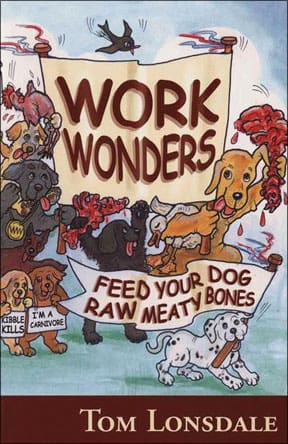
288
This book is too limited to be of much use, and doesn’t allow for variation in a dog’s needs. It also fails to address potential problems caused by bones.
I am even more unimpressed with Schultze’s newer book, The Natural Nutrition No-Cook Book (Hay House, 2005). In this book, Schultze offers human-style recipes, divided into sections such as Beverages (10 recipes); Dressings, Dips, Sauces, and Salsas (10); Fruit (15); and Vegetables (17). No attempt has been made to make these recipes complete; the book has no value to those who want to feed a complete and balanced homemade diet to their dogs.
Alternate paradigm: The “whole prey” diet
Tom Lonsdale, another Australian vet, advocates a raw diet based on whole prey. I am not a fan of this style of feeding, as I feel it is impractical. It’s also restrictive; just because foods such as vegetables were not part of the evolutionary diet of wolves does not mean they provide no nutritional benefits. This book is the best guide available, however, for people who choose this feeding method. I’ll describe the distinguishing features of the diet and let you decide whether it appeals to you.
Lonsdale’s recommended diet consists of 70 percent RMBs, plus offal and table scraps. Lonsdale asserts that RMBs should come preferably from whole carcasses, such as rats, mice, and quail for small dogs; calf, goat, pig, kangaroo, and lamb for larger dogs; and rabbit, fish, and chicken for all dogs. Other recommended RMBs include chicken and turkey backs and frames (meat removed); poultry heads, feet, necks, and wings (small dogs only); sheep, deer, pig, and fish heads; lamb and pork necks; ox and kangaroo tails; sides of lamb; slabs of beef; and ox brisket. Table scraps and fruit are also allowed.
Large meals of liver are fed once every two weeks. Other offal deemed suitable by Lonsdale include lung, trachea, heart, omasum (part of the stomach of ruminants), tripe, tongue, pancreas, and spleen. Lonsdale says that if you can’t get offal, it’s acceptable to feed 100 percent of the diet as RMBs; he states, “Many of my clients fed almost exclusively chicken backs and frames – whether to adult dogs or litters of puppies – and their animals showed excellent health.” I do not recommend this!
Ground RMBs are not allowed by Lonsdale except for dogs with no teeth or health issues such as megaesophagus or pyloric stenosis; ground food can also be fed to sick dogs for short periods only. Problems with RMBs such as choking are blamed on feeding pieces that are too small. Foods to be avoided include excessive meat off the bone, excessive vegetables, small pieces of bone, garlic, and milk.
Lonsdale is opposed to adding supplements such as glucosamine, chondroitin, flaxseed oil, and kelp. He advises against using vitamin and mineral supplements for any dog, including pregnant bitches and puppies, saying they can be harmful.
Lonsdale suggests feeding dogs once a day, and fasting healthy, adult dogs one or two days a week; he also suggests fasting “fat dogs” for “lengthy periods . . . even several weeks” (which I consider abusive). One feeding method is to feed several days’ supply of food in one large piece, returning what is left to the refrigerator after the dog has eaten his share. Part-eaten bones can also be left outside “for further gnawing over ensuing days.”
Lonsdale and his followers are adamant that there is only one right way to feed dogs; no deviation is permitted.
Lonsdale has another book, Raw Meaty Bones: Promote Health (Rivetco P/L, 2001), which is not a how-to book; it’s mostly a history of Londsdale’s war with the pet food industry.
Mary Straus investigates canine health and nutrition topics as an avocation. She is the owner of the DogAware.com website. She and her Norwich Terrier, Ella, live in the San Francisco Bay Area.



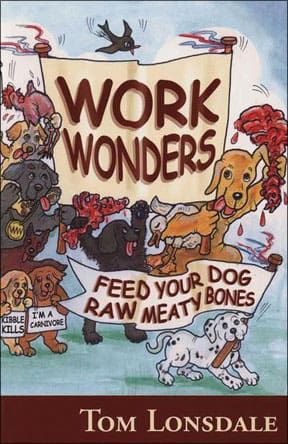
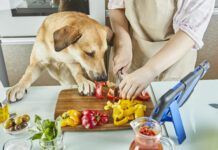

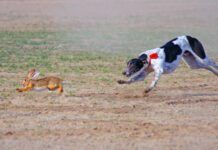
My lab 9 years old started eating cow pies.
What might he be missing?
He’s clearly missing cow pies. Anything other than that would be sheer speculation. Many dogs just enjoy eating various sorts of poop, and maybe your dog just discovered this delicacy, but if you’re feeding a homemade diet, you should make sure that it is complete and balanced. If you’re unsure, you could try putting him on a commercial complete and balanced diet and see if he stops eating the cow pies, though if he doesn’t stop, that won’t tell you anything as he may have just learned to enjoy them. Cow pies can be dangerous if they contain medications recently given to the cows.